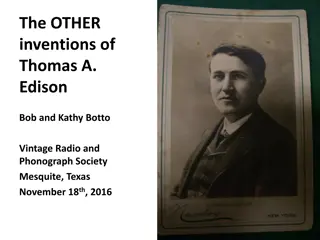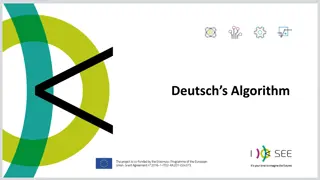China National Intellectual Property Administration Discussion on Algorithm-related Inventions
The China National Intellectual Property Administration conducted a discussion on the patentability of algorithm-related inventions, exploring various supporting technologies for the Metaverse, examination criteria and principles for patent eligibility, and examination practices and examples. Key points include the technical aspects of algorithms, establishment of mathematical models, and the application of AI in patent evaluations.
Download Presentation

Please find below an Image/Link to download the presentation.
The content on the website is provided AS IS for your information and personal use only. It may not be sold, licensed, or shared on other websites without obtaining consent from the author.If you encounter any issues during the download, it is possible that the publisher has removed the file from their server.
You are allowed to download the files provided on this website for personal or commercial use, subject to the condition that they are used lawfully. All files are the property of their respective owners.
The content on the website is provided AS IS for your information and personal use only. It may not be sold, licensed, or shared on other websites without obtaining consent from the author.
E N D
Presentation Transcript
China National Intellectual Property Administration Discussion about Patentability of Algorithm-related Inventions WIPO 7th IP & Frontier Technologies Conversation | March 30th, 2023 Presented by SU Dan
Supporting Technologies of Metaverse AI Modeling & simulation A Augmented Reality Game Big Data 3D rendering G B Natural Language Processing Algorithm Metaverse Game Engine I T Non-Fungible Token Image Recognition Interactivity Internet of Things N Digital Twin Avatars 1 Network
Examination Criteria and Principles For example, if each step refer to an algorithm involved closely related to problem to be solved, for example, the data processed by the algorithm is the data with exact technical meanings in a technical field, and the execution of the directly reflect the process of solving a technical problem by applying the laws of nature and obtain technical effects, the solution defined in the claim generally solution as provided for in Article 2.2 Chinese Patent Law. applied algorithm in a claim is the technical general algorithm basic algorithm algorithm can text image audio video is the technical posture gesture motion path ... 3
Examination Practices & Examples CASE 1 A method for establishing a mathematical model, which is characterized by comprising the following steps: -- training the initial feature extraction model according to the feature values in the training samples of the first classification task and the feature values in the training samples of at least one second classification task to obtain the target feature extraction model; wherein the second classification task is other classification task related to the first classification task; -- according to the target feature extraction model, processing the feature values in each training sample of the first classification task to obtain the extracted feature values corresponding to each training sample; -- combining the extracted feature values and label values corresponding to each training sample to extracted training samples, and training the initial classification model to obtain the target classification model; -- combining the target classification model and the target feature extraction model to form a mathematical model of the first classification task. Abstract Algorithm A25 4
Examination Practices & Examples CASE 2 A method for mining a block comprising a block header, as a function of a selected hash function applied on the block header, the selected hash function comprising an expansion operation and a compression operation, the method comprising the steps of: -- developing a plurality, m, of mid-states, each as a function of selectively varying a selected first portion of the block header; -- performing the expansion operation on a selected second portion of the block header to produce a message schedule; and -- for each of the m mid-states, performing the compression operation on the mid-state and the message schedule, to produce a respective one of m results. Not Technical Solution 6
Examination Practices & Examples CASE 3 A method for detecting a fall state of a humanoid robot based on multi-sensor information, characterized by comprising the following steps: (1) Establish a hierarchical sensor information fusion model by fusing the posture sensor information, zero-moment point ZMP sensor information and robot walking stage information; (2) Use the front and rear fuzzy decision-making system and the left-right fuzzy decision-making system to determine the stability of the robot in the front and rear directions and the left and right directions. The specificsteps are as follows: -- Determine the walking stage of the robot according to the contactsituation between the supporting feet of the robot and the ground andoffline gait planning; -- Using fuzzy inference algorithm to fuzzify the position information of ZMP points; -- Using fuzzy inference algorithm to fuzzify the pitch angle or roll angle of the robot; -- Determine the output membership function; Eligible Subject Matter -- Determine fuzzy inference rules according to steps 1~step4. 5
Examination Practices Following the development of frontier technologies Guidelines Guiding Cases Adjusting examination rules if necessary 8
China National Intellectual Property Administration Thanks ! 9























